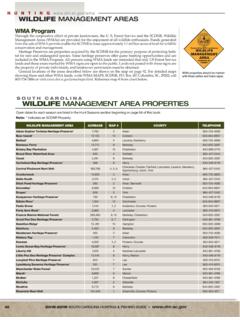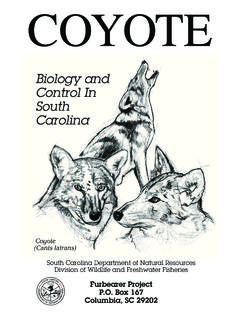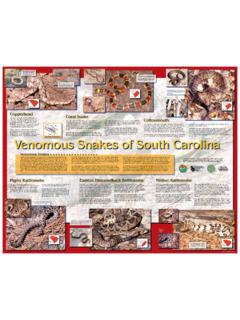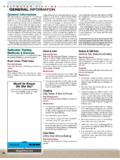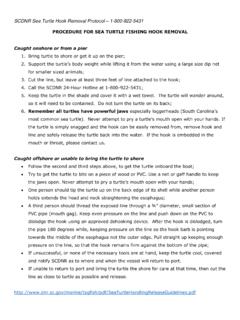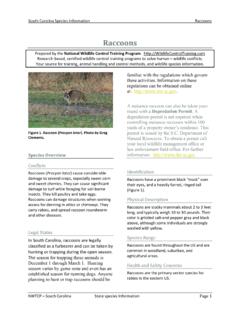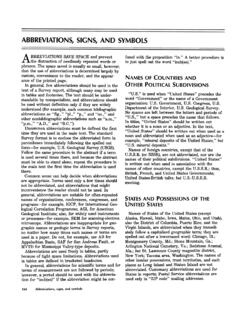Transcription of Geologic Time and Earth’s
1 Geologic Time and Earth s Biological HistoryDesigned to meet South Carolina Department of Education 2005 Science Academic Standards What is the Geologic Time Scale? (slide 4)Standard `Epochs, Eons, Eras, and Periods (slide 4) How was the time scale and it s divisions created? (slide 5) A complete Geologic Time Scale with references to (slides 6-7)Table of Contents Principles of the Geologic Time Scale (slide 8) Principles of Superposition, Horizontality and Original lateral continuity Principle of biologic succession (slide 9) Charles Lyell, the Principle of cross-cutting relations & Inclusion principle (slide 10) Charles Darwin Relative Age Dating using unconformities (slide 10)Standard Relative Age dating using cross-cutting relations and index fossils (slide 11) Absolute Age dating (slide 13) Isotopes and radiometric dating Carbon dating (slide 14) How old is old? (slide 16) Breakdown of Geologic time periods Are we now living in the Anthropocene Era? (slide 17)2 Table of Contents, cont.
2 (2 of 2) The Earth through time (slide 19)Standard Ordovician and Silurian Devonian, Mississippian, Pennsylvanian (slide 21) Permian and Triassic (slide 22) Jurassic and Cretaceous (slide 23) Triassic and Quaternary (slide 24) Adaptation (slide 25)Standard Punctuated events through time (slide 26)Standard Comet impact Climate shift Volcanism Extinction (slide 29)Standard The study of fossils and fossil types (slide 30)Standard South Carolina Standards (slide 32)3 What is the Geologic Time Scale?What does the time scale represent? (geo:rock,chronology:time). Mostoftheselife-formsarefoundasfossils, ,scientistsmaynothaveconcludedthattheear thhasahistorythatlongprecedesmankind. The Geologic Time Scale is divided by the following divisions:Standard : Recognize the relationship among the units era, epoch, and period into which the Geologic time scale is divided. Eons: Longest subdivision; based on the abundance of certain fossils Eras: Next to longest subdivision; marked by major changes in the fossil record Periods: Based on types of life existing at the time Epochs:Shortest subdivision; marked by differences in life forms and can vary from continent to of ContentsWhat is the Geologic Time Scale, continued?
3 Duetothefactthatearlygeologistshadnowayo fknowinghowthediscoveriesoftheEarthwereg oingtodevelop, ,fromaperson,orfromthetypeofrockthatdomi natedtheunit. TheearliesttimeoftheEarthiscalledtheHade anandreferstoaperiodoftimeforwhichwehave norockrecord,andtheArcheanfollowed, , ,includingpresentday,belongstothePhanero zoicEon. Whiletheunitsmakingupthetimescalearecall edgeochronologicunits, , Devonian:Namedaftersignificantoutcropsfi rstdiscoverednearDevonshire,England Jurassic:Namedforrepresentativestratafir stseenintheJuraMountainsbyGermangeologis tHumboldtin1795) Cretaceous:FromtheLatin creta meaningchalkbyaBelgiangeologist5 Table of ContentsGEOLOGIC TIME SCALEMYAERAPERIODEPOCHPLATE Age of Mammals QuaternaryHoloceneBeaches and barrier islands form-Mastadons become extinct-Human culture flourishes-Accelerating extinction of many sheets form-Modern humans develop-Asians arrive and settle the activity in North America and Africa-Grand Canyon formsHominids form in , mastadons, mammoths, tigers, and camels live in South uplift; erosion increasesCats, dogs, and apes levels rise; deposits of marine sediments limestone in ; land bridges form-Grass spreads widely-Diverse array of animals develop, including whales, rhinos, and common.
4 Georgia Embayment, Cape Fear Arch forms in Southeast-First horses appear (size of a cat)-Tropical plants dominate144 Mesozoic Age of Reptiles CretaceousMass extinction occurs at the end of the period caused by a meteorite impact (Dinosaurs, ammonites and 25% of marine life become extinct)-T-Rex develops but number of dinosaur species decline-Snakes appear and first primates appear-Angiosperms appear206 JurassicWestern US: orogeny of Rockies; North America continues to rotate away from Africa-First birds appear-Golden age of dinosaurs248 Triassic-Pangea begins to break apart-Rocky Mountains and Sierra Nevada formFirst dinosaurs, mammals, crinoids, and modern echinoids appear290 Permian-Pangeaforms-Appalachians rise-90% of Earth s species become extinct, including trilobites, blastoids, fish and amphibians because of heavy volcanism in Siberia6 Table of Contents320 CarboniferousPennsylvanianGreat swamps develop (future coal deposits-Reptiles develop from amphibians-Flying insects appear354 MississippianMuch of North America is under water-First seed plants appear-Sea life flourishes including coral, brachiopods, blastoids, and bryozoa417 DevonianAcadian Orogeny SC metamorphism-Dominant animals.)
5 Fish-Amphibians, evergreens and ferns appear443 SilurianExtensive erosionFirst land plants appear and land animals follow490 Ordovician-Beginning of the construction of South Carolina-Great extinction due to growth of ice caps including in what is now northern Africa-First animals with bones appear-Dominant animals: marine invertebrates including corals and near the equator; island arc continues to move toward North America-Explosion of life-All existing phyla came into being here-Life forms in warm seas as oxygen levels rose enough to support life-Dominant animals: trilobites and brachiopods4600 Precambrian(Hadean, Archean, and Proterozoic Ages)Earth takes 10 million years to cool: initial atmosphere escapes into space (H&He) and the core forms (Fe&Ni)Volcanic outgassing of water and carbon dioxide occurred for millions of years, helping to build atmosphere and then oceansAt 3 billion years ago, banded iron formation rocks appear due to rising oxygen levels in the atmosphere and seaNo life possible as the Earth initially forms billion years ago.
6 Simple, single-celled forms of life appear billion years ago. They will become more complex and successful over the next 3 billion years: Prokaryotes then EukaryotesCyanobacteriabegins producing free oxygen (photosynthesis)Paleozoic Age of Invertebrates Modified after Carolina Rocks, contributed by J. Westmoreland7 Table of ContentsPrinciples Behind Geologic Time NicholasSteno,aDanishphysician(1638-1687 ), : Theprincipleofsuperposition:Thelayeronth ebottomwasdepositedfirstandsoistheoldest Theprincipleofhorizontality:Allrocklayer swereoriginallydepositedhorizontally. Theprincipleoforiginallateralcontinuity: Originallydepositedlayersofrockextendlat erallyinalldirectionsuntileitherthinning outorbeingcutoffbyadifferentrocklayer. These important principles have formed the framework for the Geologic area of stratigraphy, which is the study of layered rock (strata). Decadeslater,otherEuropeanscientistsredi scovered Steno sLaws Neptunists. Anopposingview(byVoisins) plutonists. OlderYoungerGeologist studying the stratigraphy in the Copper Basin, Idaho.
7 These rock layers were deposited horizontally, and uplifted later so they are now tilted at an angle (along the red arrow). (Photo contributed by K. McCarney-Castle)8 Table of Contents JamesHutton,aScottishphysicianandgeologi st(1726-1797),thoughtthesurfaceoftheeart hwasanever-changingenvironmentand thepasthistoryofourglobemustbeexplainedb ywhatcanbeseentobehappeningnow. Thistheorywascalled uniformitarianism, whichwaslatercatch-phrasedas thepresentisthekeytothepast. ,hewasabletocorrelatestratawiththesamefo ssilsformanymiles,givingrisetotheprincip leofbiologicsuccession. Theprincipleofbiologicsuccession:Eachage intheearth , , kmRock Outcrop 1 Rock Outcrop 2 Principles Behind Geologic Time, continued9 Table of Contents Duringtheearly1800 s,EnglishGeologist,CharlesLyellpublished abookcalled PrinciplesofGeology, sideas,andpresentedhisowncontemporaryide assuchas: Theprincipleofcross-cuttingrelationships :Arockfeaturethatcutsacrossanotherfeatur emustbeyoungerthantherockthatitcuts. Inclusionprinciple:Smallfragmentsofonety peofrockbutembeddedinasecondtypeofrockmu sthaveformedfirst,andwereincludedwhenthe secondrockwasforming.
8 Thetheoryofnaturalselectionwascreditedto Darwin(alongwithAlfredRusselWallace)andh ewentontowritethefamous OriginofSpecies. Darwin CharlesDarwin(1809-1882) , ,noonespeciesoverwhelmedtheEarth, Behind Geologic Time, continued10 Table of ContentsStandard : Infer the relative age of rocks and fossils from index fossilsand the ordering of the rock layers. Relativeage meanstheageofoneobjectcomparedtotheageof another, (lithology)orfossiltype(biology)usingspe cies,composition, matchedup, wecanguessthattheywereformedduringthesam eperiod,sotheyusuallyarethesameage. Usingtheprinciplesoforiginalhorizontalit yandsuperposition,wecanconcludethatoldes trockisalwaysonthebottombecauseiswasdepo sited1st. Decipheringthesequenceofarockoutcropisso metimescomplicatedbyafeatureswithinthero ckrecordcalledunconformities, :Sedimentisdepositedontopoferodedvolcani cormetamorphicrock(indicatesverylongpass ageoftime)Relative Age DatingWikipedia (public domain)Tilted bed of sedimentary rockHorizontal bed of sedimentary rock11 Table of ContentsRelativeAgedatingwithindexfossil s (orguidefossils)becausetheycanbeusedasgu idesforrecognitionofchronostratigraphicu nits.
9 Indexfossilsarewidespread,haveshorttempo raldurationsresultingfromrapidlifespans, areabundantthroughouttheirgeographicandg eologicranges,andareeasilyrecognized(uni que). RelativeagescanalsobedeterminedusingLyel l ,boththegrayandtheyellowhorizontalstrata neededtobeinplaceforthepinklayertocutthe m,therefore,thepinklayeristheyoungest.(I magefromPlummer/McGeary,7thedition,1996) ,suchthatwecancomparerocklayersthatconta intrilobiteswithasecondrocklayerand,base donposition, ( ) of ContentsAbsolute Age Dating Absoluteages,orgeochronometricages, ,whichreliesonsequencingofrocklayers( ),absolutedatingcanproduceanactualageiny ears. Thenumberofneutronsinanucleusofanatomdet erminestheisotopeoftheelement,justliketh enumberofprotonsdeterminestheidentityofa nelement. ,whereaneutronchangesintoaprotonbygiving offanelectron,andalphadecay, : Radioactive isotopes can be found in the rock record because radioactive isotopes are incorporated into the crystals of igneous rock as it cools. WhatisaHalf-Life? oftheparentatomsintheisotopetodecay.
10 Ifanisotopehasahalf-lifeof4000years,then after4000years , of remains,or (12,000yearstotal), moreoftheremainingamountdecays,soafter3h alf-lives,thereonlyremains1/8( of of )oftheoriginalparentisotope. Ifascientistknowsthehalf-lifeoftheparent andmeasurestheproportionofparentisotopet odaughterisotope, of , DecayRadiocarbon Dating Radiocarbondatingisacommonmethodusedtoda teanythingthatwasoncealive(includingplan ts)andupto70,000yearsold. , Carbondatingcanbeusedonwood,plants,human s,andevenoldpapermadeoutofpapyrus. Thehalf-lifeofC-14is5, ,itshouldnotbeusedwithmaterialolderthan~ 70,000yearsor12half-lives. Isotopes with very long half-lives are not suitable for dating rocks younger than ~1 million years because there are too few daughter atoms to be measured accurately. Experimental error limits measurements to those rocks younger than about 12 half-lives of the isotope of ContentsParentDaughterhalf-lifeMineral or MaterialUranium238 Lead BYZircon, Uraninite, PitchblendeUranium 235 Lead 207704 MYZircon, Uraninite, PitchblendePotassium 40 Argon BYMuscovite, biotite, hornblende, K-feldspar, volcanic rock, glauconite, conodontsRubidium 87Sr BYK-mica, K-feldspar, Biotite, MetamorphicsThorium 230 Lead 20675 KYOcean sedimentsThorium 232 Lead BYZircon, Uraninite, PitchblendeCarbon 14 Nitrogen 145730 yrWood, bone, shellCommonly used radioactive isotopesUranium-Lead decay series (U-Pbseries) Unlikecarbon-14dating,uraniumdatingcanno tbeusedtodateformerlylivingthings;howeve r,itisthemostcommonlyusedmethodinigneous rockdatingbecauseoftheabundanceofzirconm inerals.

